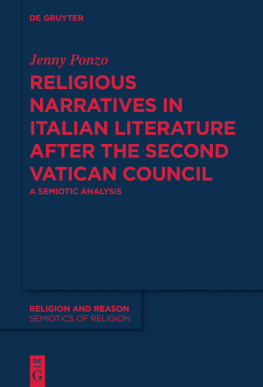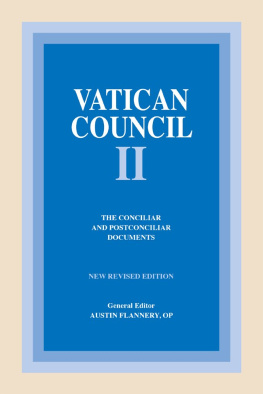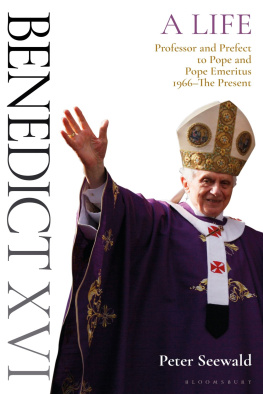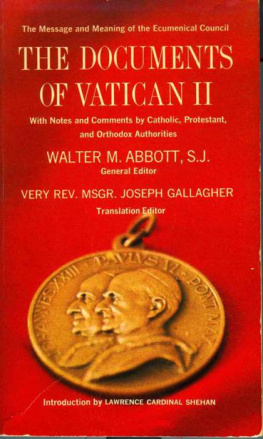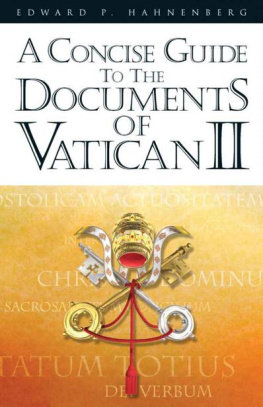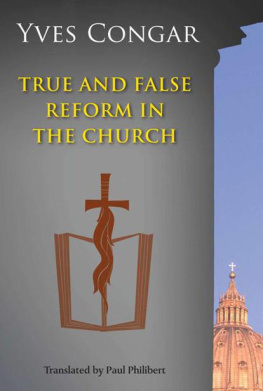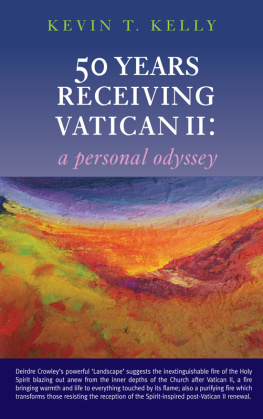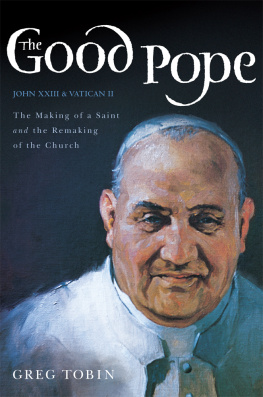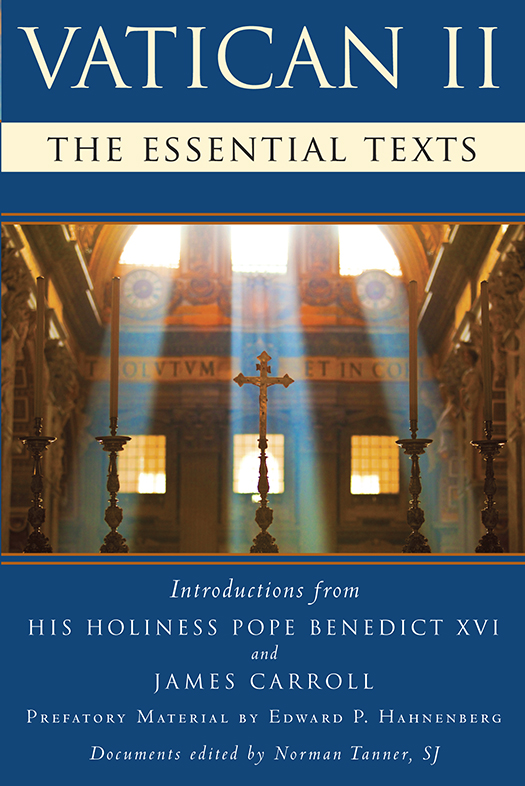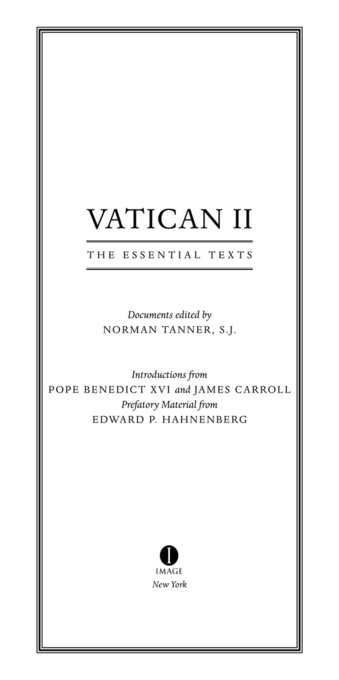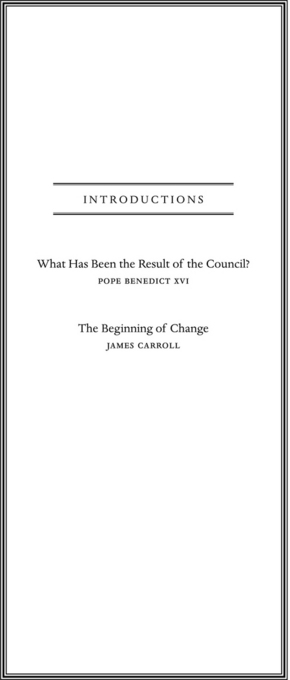Compilation and document introductions copyright 2012 by Image Books, an imprint of the Crown Publishing Group, a division of Random House, Inc.
The Beginning of Change copyright 2012 by James Carroll
Address of Pope Benedict XVI to the Roman Curia copyright 2005 by Libreria Editrice Vaticana
All rights reserved.
Published in the United States by Image Books, an imprint of the Crown Publishing Group, a division of Random House, Inc., New York.
www.crownpublishing.com
Image is a registered trademark and the I colophon is a trademark of Random House, Inc.
The documents comprising this work were originally published by the Libreria Editrice Vaticana, Stato della Citta del Vaticano, Italy. Sacrosanctum Concilium, Lumen Gentium, Nostra Aetate, Dei Verbum, Dignitatis Humanae, and Gaudium et Spes original text copyright 1972 by Istituto per le scienze religiose, Bologna, and Address of Pope Benedict XVI to the Roman Curia copyright 2005 by Libreria Editrice Vaticana.
Grateful acknowledgment is made to Continuum International Publishing Group for permission to reprint the English translations of Sacrosanctum Concilium, Lumen Gentium, Nostra Aetate, Dei Verbum, Dignitatis Humanae, and Gaudium et Spes from Decrees of the Ecumenical Councils, Volume II edited by Norman P. Tanner, S.J., English translation copyright 1990 by Sheed & Ward Limited and the Trustees for the Roman Catholic Purposes Registered. Published in Great Britain by Sheed & Ward, London, and in the United States by Georgetown University Press, Washington, DC.
Library of Congress Cataloging-in-Public Data
Vatican Council (2nd : 19621965)
[Documents of Vatican II. English. Selections]
Vatican II : the essential texts / documents edited by Norman Tanner ; with essays from Pope Benedict XVI, James Carroll and Edward P. Hahnenberg.
p. cm.
1. Vatican Council (2nd : 19621965) 2. Catholic ChurchDoctrines.
I. Benedict XVI, Pope, 1927 II. Carroll, James, 1943 III. Hahnenberg,
Edward P. IV. Title.
BX8301962.A3 T36 2012
262.52dc23
2011052077
eISBN: 978-0-307-95293-6
Cover design by Laura Duffy
Cover photography by Richard lAnson/Lonely Planet Images
v3.1
Contents
What Has Been the Result of the Council?
BY POPE BENEDICT
The Beginning of Change
BY JAMES CARROLL
DOCUMENTS
WITH PREFATORY MATERIAL
BY EDWARD P. HAHNENBERG
Constitution on Sacred Liturgy
(Sacrosanctum Concilium)
Dogmatic Constitution on Divine Revelation
(Dei Verbum)
Dogmatic Constitution on the Church
(Lumen Gentium)
Pastoral Constitution on the Church in the Modern World
(Gaudium et Spes)
Declaration on Religious Freedom
(Dignitatis Humanae)
Declaration on the Churchs Relation to Non-Christian Religions
(Nostra Aetate)
What Has Been the Result of the Council?
POPE BENEDICT XVI
What has been the result of the Second Vatican Council? Was it well-received? What, in the acceptance of the Council, was good and what was inadequate or mistaken? What still remains to be done? No one can deny that in vast areas of the Church the implementation of the Council has been somewhat difficult, even without wishing to apply to what occurred in these years the description that St. Basil, the great Doctor of the Church, made of the Churchs situation after the Council of Nicaea: he compares her situation to a naval battle in the darkness of the storm, saying among other things: The raucous shouting of those who through disagreement rise up against one another, the incomprehensible chatter, the confused din of uninterrupted clamouring, has now filled almost the whole of the Church, falsifying through excess or failure the right doctrine of the faith
We do not want to apply precisely this dramatic description to the situation of the post-conciliar period, yet something from all that occurred is nevertheless reflected in it. The question arises: Why has the implementation of the Council, in large parts of the Church, thus far been so difficult?
Well, it all depends on the correct interpretation of the Council oras we would say todayon its proper hermeneutics, the correct key to its interpretation and application. The problems in its implementation arose from the fact that two contrary hermeneutics came face to face and quarrelled with each other. One caused confusion, the other, silently but more and more visibly, bore and is bearing fruit.
On the one hand, there is an interpretation that I would call a hermeneutic of discontinuity and rupture; it has frequently availed itself of the sympathies of the mass media, and also one trend of modern theology. On the other, there is the hermeneutic of reform, of renewal in the continuity of the one subject-Church which the Lord has given to us. She is a subject which increases in time and develops, yet always remaining the same, the one subject of the journeying People of God.
The hermeneutic of discontinuity risks ending in a split between the pre-conciliar Church and the post-conciliar Church. It asserts that the texts of the Council as such do not yet express the true spirit of the Council. It claims that they are the result of compromises in which, to reach unanimity, it was found necessary to keep and reconfirm many old things that are now pointless. However, the true spirit of the Council is not to be found in these compromises but instead in the impulses toward the new that are contained in the texts.
These innovations alone were supposed to represent the true spirit of the Council, and starting from and in conformity with them, it would be possible to move ahead. Precisely because the texts would only imperfectly reflect the true spirit of the Council and its newness, it would be necessary to go courageously beyond the texts and make room for the newness in which the Councils deepest intention would be expressed, even if it were still vague.
In a word: it would be necessary not to follow the texts of the Council but its spirit. In this way, obviously, a vast margin was left open for the question on how this spirit should subsequently be defined and room was consequently made for every whim.
The nature of a Council as such is therefore basically misunderstood. In this way, it is considered as a sort of constituent that eliminates an old constitution and creates a new one. However, the Constituent Assembly needs a mandator and then confirmation by the mandator, in other words, the people the constitution must serve. The Fathers had no such mandate and no one had ever given them one; nor could anyone have given them one because the essential constitution of the Church comes from the Lord and was given to us so that we might attain eternal life and, starting from this perspective, be able to illuminate life in time and time itself.


